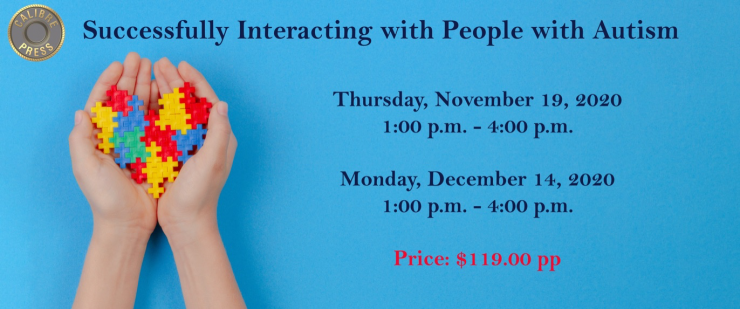By Sgt. Stefan Bjes
[Editor’s note: Be sure to check out the new Calibre Press course, “Successfully Interacting With People With Autism“]
Imagine you are looking for a missing child and after a lengthy search you locate them. As you approach the child you learn that they are unable to communicate due to an Autism diagnosis. Are you prepared to handle a situation like this…to communicate with a person who may be nonverbal?
An event similar to this just occurred in Stockton, California. During the interaction a Stockton police officer got down on his knees and used a piece of paper and pencil in an attempt to communicate with the young boy. Through this simple use of an alternative form of communication, the young boy was successfully reunited with his family.
In reality, incidents like this occur on a regular basis all over the country. According to the National Autism Association, it is estimated that 40% of the population with Autism Spectrum Disorder (ASD) are either nonverbal or have limited verbal ability. Autism affects a person’s receptive and expressive language.
Receptive language is the ability to understand words and language and is imperative to communicate successfully. Individuals with Autism who have difficulties with comprehension may find it challenging to follow instructions and may not respond appropriately to questions or requests.
Expressive language has to do with functional communication. Expressive language or communication may be accomplished through language, sign language, gestures or other forms of alternative communication. In addition to language deficiencies, a major characteristic associated with Autism is difficulty receiving and expressing emotion as well as difficulty in using non-verbal social communication. (Body language, facial expressions, eye contact, gestures and tone of voice/intonation). When you combine all of this with the presence of a police officer during an emergency call for service or a stressful situation, communicating may seem impossible.
This article will discuss different communication strategies to utilize during interactions with people on the Autism spectrum. It’s always important to remember that no two individuals with ASD are the same. Although a strategy that works for one might not work for another, there are some tested techniques police can use to attempt communication with someone who is non-verbal.
1. Address the person as you would anyone else: Do not always assume that the person with whom you are interacting has limited cognitive ability. In other words, they may be able to understand every word that is being said but may have difficulty in responding verbally.
2. Verbal techniques: There are some important techniques that officers should utilize when trying to communicate verbally. One of the first things you should do is state the obvious; tell them who you are and what you are there to do. An individual with ASD may not understand the meaning behind our uniform or badge.
Officers should speak in direct short phrases such as “stand-up,” “sit down,” or “stay right here.” Speak in a calm, quiet voice and provide only one command at a time. Individuals with Autism are very literal thinkers. Therefore, officers should refrain from using slang or abstract language. For example, if you ask them “take a seat” they may actually pick up the chair and try to walk away with it.
Another verbal strategy is “first – then – praise.” An example of this would be “first we are going to stand-up, and then we will walk to the car”. Once a request is completed, verbal praise should be given. Example, “Great job standing-up and walking to the car.”
If the individual is able to speak, but fails to answer questions, try utilizing fill-in-the-blank questions. “Your name is…?” “Your address is…?” It’s easier to provide a one-word response than a complete sentence. Individuals with ASD are all about routines and the “rules.” This can be used to an officer’s advantage by saying, “The rules say you need to walk with me.” Often, including the phrase “the rules” will get them to successfully comply.
3. Echolalia/Scripting: Echolalia is the repetition of phrases or words and is one of the most common characteristics of communication in people with ASD. Immediate echolalia is when the person with ASD repeats back something immediately. An example would be, “Are you hurt?” and the person would respond with “You are hurt.” In this instance the person may actually be hurt but may not have the ability to respond with an appropriate response like “Yes, I am hurt.”
Scripting is where a person with ASD memorizes phrases from books, movies or videos and those phrases are repeated after a period of time following the hearing of a phrase. The recited phrase may or may not be appropriate for the situation. In some instances, Echolalia and Scripting may have a purpose. It is important to listen to what is being said. It may give you some insight into what they are thinking or feeling.
4. Model the desired behavior: For a police officer, this may include demonstrating what you want someone to do. This may be standing up, sitting down, getting into a car or demonstrating a calm demeanor. The demeanor of the officer can significantly influence a positive or negative response from the person. It is important to remember that calm brings calm. If the person with ASD is demonstrating negative behavior, such as screaming, knocking items over, or banging on things it should be ignored, if it is safe to do so. If an officer acknowledges the negative behavior it serves as reinforcement and the behavior will continue.
5. Consider Using Assistive Devices/Visuals: There are many types of assistive devices available that are designed to help children and adults with ASD who struggle to communicate. The simplest form of a no-tech assistive device is pencil and paper. My department has started to carry a dry erase board/marker (no-tech assistive device) in our squad cars. This can be used to communicate through written words or pictures. The dry erase board can also be used as a calming strategy by letting the person draw on the board.
Departments could also consider using PECS cards (Picture Exchange Communication System). These cards contain visuals of particular actions or requests and can be designed to focus on police-related interactions. There are also many apps that can be downloaded directly to your phone or tablet that provide different types of visuals.
6. Give extra time for a response: If the person you are interacting with doesn’t respond immediately to your question, do not assume they haven’t heard or understood you. Individuals with ASD sometimes need a little more time to absorb and process information before giving their response. It may take 10-15 seconds for the person with ASD to respond to commands or questions being asked. Repeating the question every few seconds to force a response, or constantly talking, can lead to challenging behaviors as the person may become frustrated by being overwhelmed with verbal information.
7. Avoid words that act as triggers: Words such as ‘not now,’ ‘no,’ and ‘stop’ can act as triggers for challenging behavior in people with ASD. When this happens, it is necessary to find positive statements that redirect the person’s behavior. For example, the command “stop hitting” may be replaced with “let’s use nice hands.”
In summary, to increase the likelihood of positive outcomes of interactions with persons who have ASD, an officer may need to use a more restrained, quiet, calm approach. Some or all of the recommended techniques that have been described will help achieve positive outcomes with interactions with people with ASD and law enforcement.










0 Comments